
Music of Malaysia is the generic term for music that has been created in various genres in Malaysia. A great variety of genres in Malaysian music reflects the specific cultural groups within multiethnic Malaysian society: Malay, Chinese, Indian, Dayak, Kadazan-Dusun, Bajau, Orang Asli, Melanau, Kristang and others.
Dondang Sayang literally love ballad, originated in Malacca sometime in the 15th century, influenced by traditional Portuguese folk music. It is a traditional Malay form of entertainment where Baba and Nyonya singers exchange extemporaneous Malay Pantun (poetry), in a lighthearted and sometimes humorous style. The singers are normally accompanied by a violin, two Malay rebana (drums), and a tetawak (gong). These instruments are often supplemented by other available instruments, most notably, accordions, flutes, or an additional violin.

Dayang Nurfaizah binti Awang Dowty is a Malaysian singer. Her debut self-titled album was released in May 1999 and it was recorded in the pop and R&B genres. The album's lead single, Hakikat Cinta introduced her to the local music industry.

Pakaian is the term for clothing in Malaysia's national language. It is referring to things to wear such as shirts, pants, shoes etc. Since Malaysia is a multicultural nation: Malay, Chinese, Indian and hundreds of other indigenous groups of Malay peninsula and Borneo, each has its own traditional and religious articles of clothing all of which are gender-specific and may be adapted to local influences and conditions. Previously, traditional clothes were worn daily. However, by excluding Baju Melayu, Baju Kurung many are now only worn on special occasions such as marriage ceremonies and cultural events.

Kedahan Malays or commonly known as Orang Utara ('Northerners'), is a sub-group of Malays who are native to northern Malaysia and in southernmost parts of Thailand and Burma. They are among the earliest settlers in the Malay peninsula. Kedahan Malays comprised at least 15% of the total Malaysian Malay population and constitute over 75% of the Kedah state population, thus making them the largest ethnic group in the state of Kedah.

Datuk Adnan bin Abu Hassan was a Malaysian composer and musician. He is considered to be among the top notch individuals developing the Malaysian music industry.
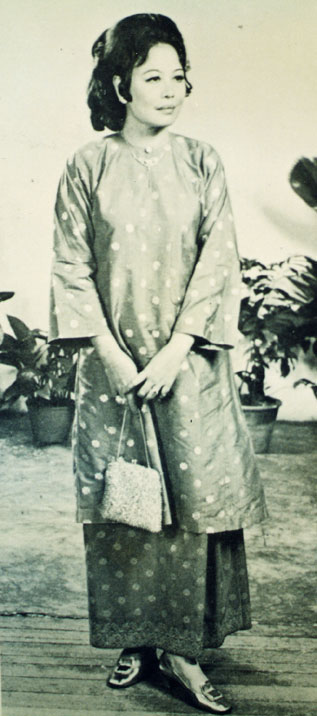
Baju Kurung is a traditional costume of Malays and traditionally worn by women in Brunei, Indonesia, Malaysia, Singapore and southern Thailand. This type of traditional costume is the national dress of Brunei and Malaysia. In Indonesia, it is also one of the regional dresses, seen most on the island of Sumatra, where many ethnic Malay and Minangkabau women wear it.
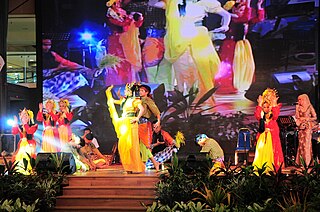
Ulek Mayang is a classical Malay dance from the state of Terengganu in Malaysia. It is a ritualistic dance performed to appease or invoke the spirits of the sea and is always accompanied by a unique song also called Ulek Mayang. An orchestra comprising drums, gong, violin and accordion accompanies the dance.
Mek Mulung is a traditional Malay theatre that unique to the northwest state of Kedah in Malaysia. It became popular since the late 18th century and incorporates most elements of Mak Yong, Menora and Hadrah. The theatre features a repertoire of stories from local legends, which according to a source, amounted about 20 original stories, with few of them survived today. Similar to Mak Yong, the stories are presented through dialogue, song and dance.
Malaysian popular music, sometimes called shortly Malaysian pop or abbreviated as M-pop, refers to popular music forms in Malaysia. Although popular music in various languages such as Mandopop are popular and have been produced in Malaysia, Malaysian pop refers to music recorded primarily in the Malay language in Malaysia.
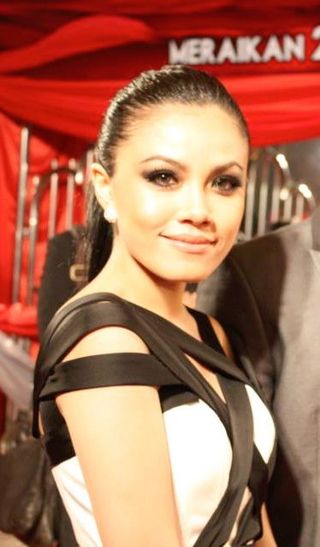
Siti Zaqyah Abdul Razak, known professionally as Tiz Zaqyah, is a Malaysian actress, model and singer. She debuted in 2006 and since then has starred in films, dramas, telemovies and television and magazine advertisements. She rose to fame for playing the role of Nur Amina in the 2009 hit drama Nur Kasih with Remy Ishak, Fizz Fairuz and Sharifah Sofia. She became best known for her leading roles in Asmaradana, Gemilang, Soffiya, Dejavu di Kinabalu, Sebenarnya, Saya Isteri Dia! where she played a role of Shaf alongside Izzue Islam, Cinta Jangan Pergi where she acted with her acclaimed former counterpart partner, Remy Ishak, Jodoh Itu Milik Kita and Kusinero Cinta.

Kelantanese Malays are a sub-ethnic group of Malays native to the state of Kelantan, Malaysia as well as in Northern Terengganu. The Kelantanese Malays are closely related to Thai Malays and Terengganuan Malays in neighbouring Terengganu, these two Malay sub-ethnic groups shared historical, cultural and linguistic as well as kinship ties with the Kelantanese Malays. Kelantanese Malays form 94% of Kelantan's population, which makes them the largest ethnic group in Kelantan and around 150,000 in Besut, Terengganu.

Terengganurians, Terengganuans or Terengganu Malays, are a Malay ethnic group native to the state of Terengganu, on the east coast of Peninsular Malaysia. Besides Terengganu, they can also be found in the neighbouring states of Pahang, Johor and their descendants can also be found in the Anambas Islands in Indonesia. As of 2010, it is estimated that the population of Terengganuan Malays is around 1.1 million people, and they form 94% of Terengganu's population, making them the dominant ethnic group in the state.
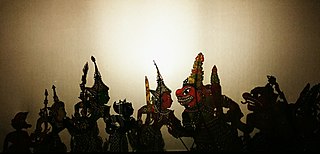
Malaysian folklore is the folk culture of Malaysia and other indigenous people of the Malay archipelago as expressed in its oral traditions, written manuscripts and local wisdoms. Malaysian folklores were traditionally transmitted orally in the absence of writing systems. Oral tradition thrived among the Malays, but continues to survive among Orang Asli and numerous bornean ethnic groups in Sarawak and Sabah. Nevertheless, Malaysian folklores are closely connected with classical Malay folklore of the region. Even though, Malay folklore tends to have a regional background, with the passing of time, and through the influence of the modern media, large parts of regional Malay folklore have become interwoven with the wider popular Malaysian folklore.
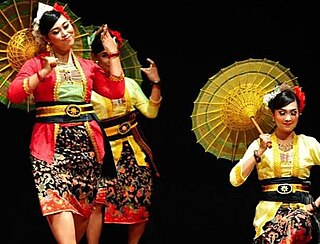
Payung dance is a folk dance-drama tradition of the Minangkabau-Malay ethnic group in Sumatra, Indonesia. This dance is a Minangkabau version of other Malay dances from Sumatra. Folk theatre such as toneel and sandiwara often incorporate payung dance as part of the show. The payung (umbrella) is the main prop used in this dance. The payung dance symbolizes affection and the relationship of young people and is usually performed by three or four dancers. The dance originates from Western Sumatra, Indonesia.
Inai dance or Terinai dance is a traditional Malay dance. This dance is a court dance performed during the circumcision ceremony of the children of the palace dignitaries. It is presented to these children as they are about to be circumcised and sit on the throne. Inai dance is popular in Perlis, northern Kedah, and Kelantan. This Inai dance is rarely performed compared to other palace dances, as it is dedicated to certain events such as weddings, circumcisions, and royal coronations.
Adai-adai dance is a traditional dance of Bruneian Malay ethnic group in Brunei Darussalam, Sabah and Labuan in Malaysia, this dance is based on the life of the fishermen. This dance tells the story of a group of fishermen who go fishing in the sea while the women wait for their return to the beach to help collect the catch that will be obtained.
Ceracap Inai dance is a type of traditional Malay folk dance popular especially in Johor.
Saba dance is a traditional Malay dance originated in the state of Terengganu, Malaysia. It is a ritualistic dance that was used for healing purposes.
Balai dance or Ulai dance is a traditional Malay dance originated from what is now the district of Hulu Terengganu in the state of Terengganu, Malaysia. It is performed usually by women during the harvest season as a way to appease the spirits of paddy crops for this year's harvest and to seek bountiful harvests for the next season.












